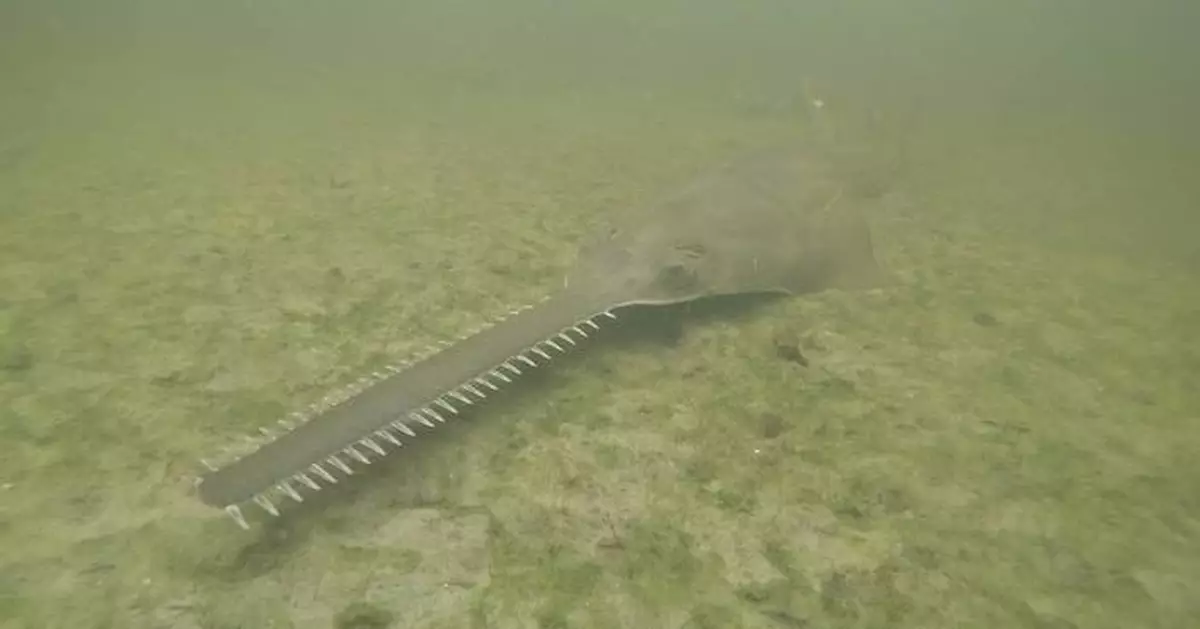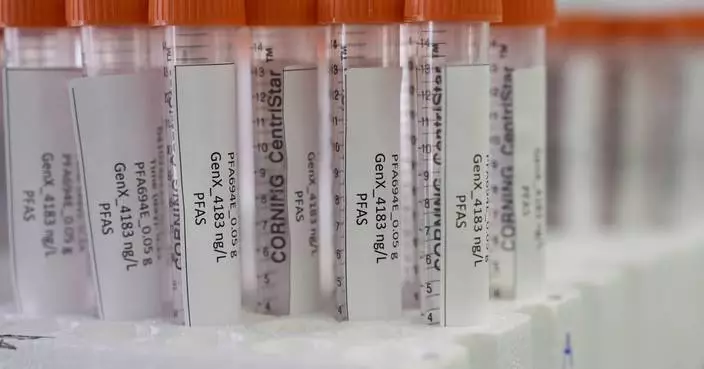ST. PETERSBURG, Fla. (AP) — Endangered smalltooth sawfish, marine creatures virtually unchanged for millions of years, are exhibiting erratic spinning behavior and dying in unusual numbers in Florida waters. Federal and state wildlife agencies are beginning an effort to rescue and rehabilitate sawfish to find out why.
The National Oceanic and Atmospheric Administration announced what it calls an “emergency response” focused on the Florida Keys starting next week. A NOAA news release called the effort unprecedented.
“If the opportunity presents itself, this would be the first attempt ever to rescue and rehabilitate smalltooth sawfish from the wild,” said Adam Brame, NOAA Fisheries’ sawfish recovery coordinator.
Sawfish, related to rays, skates and sharks, are named for their elongated, flat snout that contains a row of teeth on each side. They can live for decades and grow quite large, some as long as 16 feet (about 5 meters). They were once found all along the Gulf of Mexico and southern Atlantic coasts in the U.S., but now are mainly in southwestern Florida and the Keys island chain as their habitats shrink. A related species is found off Australia.
Since late January, state wildlife officials have been documenting what they call an “unusual mortality event” that has affected about 109 sawfish and killed at least 28 of them. There have been reports of abnormal behavior, such as the fish seen spinning or whirling in the water. Other species of fish also appear to have been affected.
“We suspect that total mortalities are greater, since sawfish are negatively buoyant and thus unlikely to float after death,” Brame said.
Officials haven't isolated a cause. The Florida Fish and Wildlife Conservation Commission reported Wednesday that sawfish necropsies have not revealed any pathogen or bacterial infections, nor problems with low water oxygen levels or contaminants such as chemicals, or toxic red tide. Water testing is continuing.
It's also not clear if the deaths and odd behaviors are related to a lengthy summer heat wave in Florida waters experts say was driven by climate change. The superheated waters caused other marine damage, such a coral bleaching and deaths of other ocean species.
The wildlife agencies are working with three organizations that will rehabilitate sawfish that are rescued. One of them, Mote Marine Laboratory and Aquarium, said in a news release that even relatively small numbers of sawfish deaths could have a major impact on the population, listed as endangered since 2003.
“We have quarantine facilities ready to accommodate rescued sawfish where they would be under observation by qualified personnel under specific care and release guidelines," said Kathryn Flowers, Mote Postdoctoral Research Fellow and lead scientist on the sawfish issue. "Attempts to solve this mystery call for robust collaboration.”
Brame said the effort depends on tips and sightings from the public of dead or distressed sawfish so rescuers know where to look for them. NOAA has a tipline at 844-4-Sawfish and FWC has an email, sawfish@fwc.com.
In recent years, threatened manatees also suffered a major die-off in Florida waters as pollution killed much of their seagrass food source. State and federal officials fed tons of lettuce to manatees that gathered in winter outside a power plant for two years, and the manatee numbers have rebounded some with 555 deaths recorded in 2023 compared with a record 1,100 in 2021.

This image provided by NOAA shows a smalltooth sawfish. Endangered smalltooth sawfish, marine creatures virtually unchanged for millions of years, are exhibiting erratic spinning behavior and dying in unusual numbers in Florida waters. Federal and state wildlife agencies are beginning an effort to rescue and rehabilitate sawfish to find out why. (NOAA via AP)
WARSAW, Poland (AP) — A war next door in Ukraine.Migration pressure at borders. Russian sabotage across the region. Doubts about the U.S. commitment to Europe's security.
In Poland’s presidential election Sunday, security looms large. So do questions about the country’s strength as a democracy and its place in the European Union. One of the new president’s most important tasks will be maintaining strong ties with the United States, widely seen as essential to the survival of a country in an increasingly volatile neighborhood.
Voters in this Central European nation of 38 million people will cast ballots to replace conservative incumbent Andrzej Duda, whose second and final five-year term ends in August.
With 13 candidates, a decisive first-round victory is unlikely. Some have appeared unserious or extreme, with a couple expressing openly pro-Putin or antisemitic views. A televised debate this week dragged on for nearly four hours. There are calls to raise the threshold to qualify for the race.
A runoff on June 1 is widely expected, with polls pointing to a likely showdown between Rafał Trzaskowski, the liberal mayor of Warsaw, and Karol Nawrocki, a conservative historian backed by the Law and Justice party, which governed Poland from 2015 to 2023.
Poland’s geography gives the election added importance. Bordering Russia’s Kaliningrad exclave, Belarus and war-torn Ukraine — as well as several Western allies — Poland occupies a critical position along NATO’s eastern flank and serves as a key logistics hub for military aid to Ukraine.
There are growing fears that if Russia prevails in its full-scale invasion of Ukraine, it could target other countries that freed themselves from Moscow's control some 35 years ago. Against that backdrop, the election will shape Warsaw’s foreign policy at a moment of mounting strain on trans-Atlantic unity and European defense.
Both leading candidates support continued U.S. military engagement in Europe. Trzaskowski puts greater emphasis on deepening ties with the European Union, while Nawrocki is more skeptical of Brussels and promotes a nationalist agenda.
When Law and Justice held power, it repeatedly clashed with EU institutions over judicial independence, media freedom and migration.
While Poland is a parliamentary democracy, the presidency wields significant influence. The president serves as commander-in-chief of the armed forces, holds veto power, shapes foreign policy and plays a symbolic role in national discourse.
Under Duda, the office largely advanced the conservative agenda of Law and Justice. Since Prime Minister Donald Tusk’s centrist coalition came to power in late 2023, Duda has blocked key reforms aimed at restoring judicial independence and repairing relations with the EU.
“The stakes are enormous for the ruling coalition and for those concerned with the future of Polish democracy,” said Jacek Kucharczyk, president of the Institute of Public Affairs, a Warsaw think tank. “This is about democratic reform and restoring the rule of law — and that can only happen with cooperation from the next president.”
The election is also pivotal for Law and Justice, Kucharczyk noted: “Its future as a dominant political force may hinge on the outcome.”
Both Trzaskowski and Nawrocki have pledged to support Ukraine and maintain strong defense ties, but their visions for Poland diverge sharply on the role of the EU and domestic social policy.
Trzaskowski, 52, is a former presidential contender and a senior figure in Civic Platform, the centrist party led by Tusk. He is running on a pro-European platform and has pledged to defend judicial independence and rebuild democratic institutions.
Supporters describe him as a modernizer who represents a cosmopolitan, outward-facing Poland. He speaks foreign languages, has marched in LGBTQ+ parades and appeals to younger, urban voters. Trzaskowski's progressive views highlight an evolution of the once more conservative Civic Platform.
Nawrocki, 42, represents how the party backing him, Law and Justice, is turning further to the right as support for the hard right grows.
Nawrocki, who is not a Law and Justice party member, heads the state-backed Institute of National Remembrance, which investigates Nazi and communist-era crimes. He has drawn praise from conservatives for dismantling Soviet monuments and promoting patriotic education, but he faces criticism for inexperience and playing on anti-German and other resentments. He has also been embroiled in some scandals.
Earlier this month, Nawrocki met with U.S. President Donald Trump at the White House — a symbolic moment welcomed by Law and Justice-friendly media as proof that he would be the best man for keeping the relationship with the United States strong. Critics viewed it as interference by Trump's administration.
This week Nawrocki was joined on the campaign trail by Romanian nationalist George Simion, who faces a runoff vote for the presidency on Sunday. Simion is viewed by critics as pro-Russian, leading Tusk to tweet: "Russia is pleased. Nawrocki and his pro-Russian Romanian counterpart George Simion on the same stage five days before the presidential elections in Poland and Romania. Everything is clear.“
AP video reporter Rafał Niedzielski contributed to this report.

Warsaw Mayor Rafał Trzaskowski, a liberal candidate in Poland's presidential election, speaks to supporters during a campaign stop, in Lodz, Poland, Friday, May 9, 2025. (AP Photo/Czarek Sokolowski)

Far-right Confederation party's presidential candidate Sławomir Mentzen poses for a photo with supporters in Saturday,Warsaw, Poland, May 10, 2025. (AP Photo/Czarek Sokolowski)

Supporters join a campaign rally in support of presidential candidate Szymon Hołownia in Warsaw, Poland ,Tuesday, May 13, 2025. (AP Photo/Czarek Sokolowski)

People carry placards in support of conservative presidential candidate Karol Nawrocki in Warsaw, Poland, Tuesday, May 13, 2025. (AP Photo/Czarek Sokolowski)

Warsaw Mayor Rafał Trzaskowski, a liberal candidate in Poland's presidential election, waves to supporters during a campaign stop, in Lodz, Poland, Friday, May 9, 2025. (AP Photo/Czarek Sokolowski)















